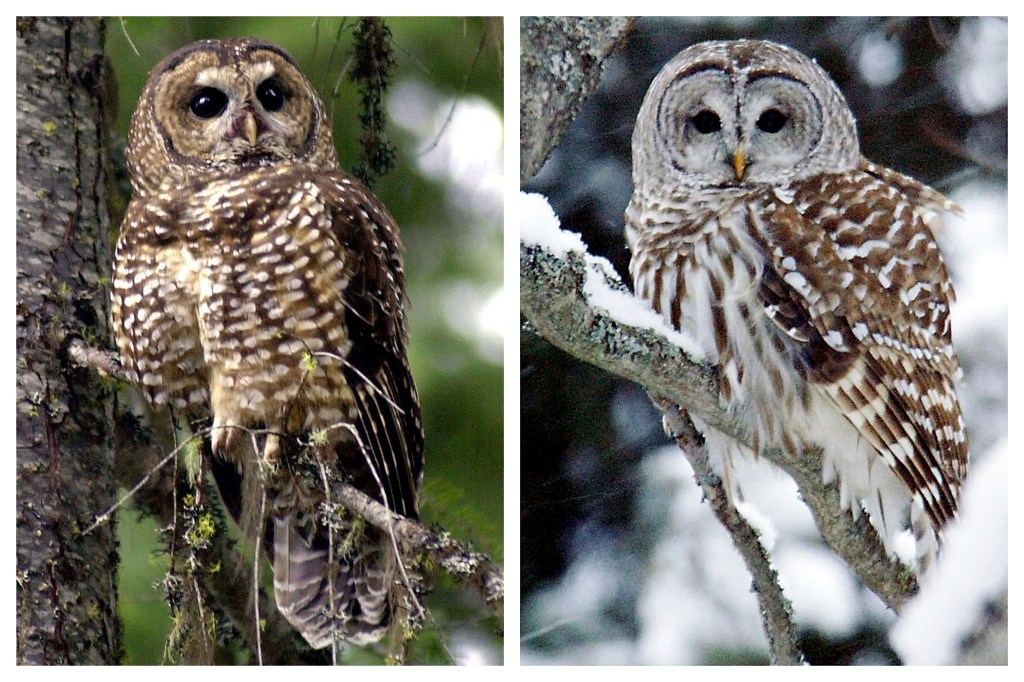It’s routine practice for government officials to kill animals deemed invasive or destructive. For the most part, Americans accept this or look the other way — especially if the “pests” are insects, rodents or garden-munching deer. That’s changed now that the Fish and Wildlife Service plans to shoot thousands of owls in California, Oregon and Washington.
The species on the hit list is the barred owl — a creature whose adaptability has enabled it to spread into new areas. This expansion is driving the increasingly rare spotted owl to extinction.
This isn’t just natural selection in action. All over the world, human activity has changed landscapes so fast that the diversity of plants and animals is collapsing — with a few hardy species taking over. In an attempt to stop this, authorities around the world are protecting coral reefs by killing starfish, protecting salmon by killing sea lions, and protecting red squirrels by killing grey ones.
But the case of the spotted owl is unusual because, to the untrained eye, it almost looks the same as a barred owl. The two species are so closely related, they sometimes mate and produce hybrid offspring. That’s forced a reconsideration of big ethical questions: Is it moral to kill in the name of ecological balance and diversity? And if it can be, how do we decide which species are acceptable to target?
Field experiments show that shooting barred owls can stave off the decline of the spotted owl, but there’s no end point. The current plan under the Fish and Wildlife Service would go on for 30 years and kill up to half a million owls — but it’s understood that the shooting would have to go on forever to save the spotted owl.
The old-growth forests
Stephen Pruett-Jones, an ecologist at the University of Chicago, said that while barred owls can interbreed with spotted owls, they are very different animals with different calls and different diets. Spotted owls only eat certain small mammals, while barred owls can eat mammals, fish, amphibians, birds, insects and slugs. Spotted owls are only adapted to live in old-growth forests; barred owls live in a much wider range of environments.
In the 1980s and 1990s, environmentalists used the spotted owl’s status under the Endangered Species Act to argue that a fraction of the old-growth forest in the Pacific Northwest should be protected from logging. They succeeded, but the spotted owls continued to decline — losing 80% of their numbers in the last 30 years.
Scientists and bird watchers witnessed the bigger, more aggressive barred owl move in and outcompete spotted owls for food and nesting sites. And it’s not just the spotted owl that’s at risk — the barred owl’s proliferation might be hurting the local screech owl and pygmy owl populations. Some scientists worry that human activity has both depleted the spotted owl populations and accelerated the barred owl’s expansion.
Kent Livezey, a retired wildlife biologist for the Fish and Wildlife Service has argued that human activity has affected owl ranges for millennia, starting when Native Americans used fire to clear land in the middle of the continent. As European colonists took over, suppressing fires and building farms, towns and parks, they helped create a corridor of trees through which barred owls slowly expanded westward along with many other birds.
Livezey said he’s not opposed to killing a few barred owls in places where spotted owls can be saved. His concern is that the government plan includes culling in areas surrounded by thousands of barred owls, so more will move in replacing any that are shot.
He worries the killing is being motivated by another reason — under the Endangered Species Act, the spotted owl is the only legal leverage preventing logging from destroying what’s left of the old-growth forests. It would be far better to create new laws to protect the forests rather than kill thousands of owls.
The one place where he thinks there’s hope for the spotted owl is in the Sierra Nevada mountains. In other places, he said, the shooting would be a waste of money and of avian life.
The barred owls
A recent New York Times op-ed piece also argues against the killing, citing “genomic evidence that the barred owl has in fact resided in the Pacific Northwest for thousands of years.” But that was at odds with what all the scientists told me, and the paper cited didn’t appear to make that case, so I called one of the authors, biodiversity scientist John Dumbacher.
He said the Times piece misrepresents his work, which, he said, shows there’s more genetic variation among barred owl populations than thought. “The data are clear at this point: The barred owl is an existential threat to the spotted owl,” he said. The spotted owl is “disappearing at a rate that’s blowing away the scientists.” If humans hadn’t drastically depleted their numbers by destroying much of the old-growth forest they depend on to survive, maybe they’d have stood up better to the barred owls.
“The science is all very clear about what’s going on,” Dumbacher said, “but the science doesn’t tell you what to do about it.” For that we need ethical arguments. The public should have a say as well.
He said he’s given public lectures on this issue and people have mixed views. He understands people’s opposition to killing charismatic creatures. He’s not opposed to taking either road, but either choice will have consequences. If we do nothing, he said, it’s all going to be dandelions and raccoons and black rats — and a few other species that can adapt to human-degraded environments.
There may be no good path forward. What may be more important is proceeding wisely — having an end goal, learning from mistakes, and doing what we can to avoid coming to this juncture in the future.
F.D. Flam is a Bloomberg Opinion columnist. ©2024 Bloomberg News. Distributed by Tribune Content Agency.
